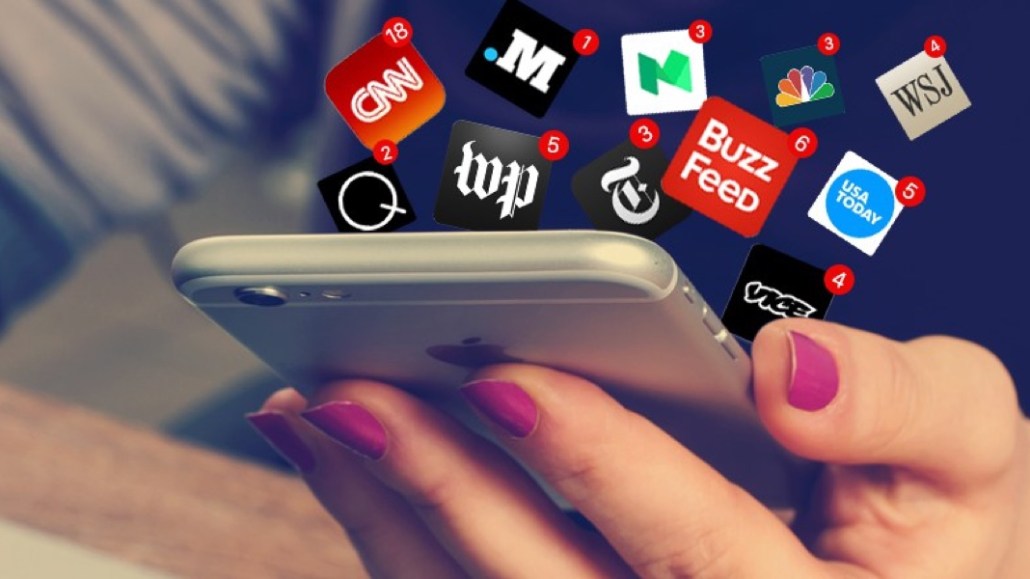Register by Jan 13 to save on passes and connect with marketers from Uber, Bose and more

Publishers have had a hard time getting mobile app users to personalize their notifications, so they’re trying new tacks.
In the past six months, publishers ranging from CNN to Bustle to The Guardian have deployed new strategies to get readers involved in their push strategies as competition for home-screen real estate heats up: According to mobile developer Urban Airship, publishers are sending 40 percent more push notifications per month compared to two years ago.
The push craze has heated up because pushes work, and now that mobile visitors now account for a majority of most publishers’ traffic, push notifications have grown from a curiosity into a core component of many publishers’ engagement and retention strategies. Data compiled this spring by Urban Airship found that publishers who push at least one notification to their app users every day have app retention rates more than twice as high as those for publishers that don’t.
Bustle, which gets users to spend an average of six minutes on its app, has been overhauling its notification strategy for the past three months. The Guardian, which won an award this year for using notifications to share continuously updated election data, recently began offering users a different kind of content, giving its mobile app users the chance to opt into Weekend Read notifications, which push the Guardian’s long-form pieces right to readers’ phones. And when CNN relaunched its mobile app in February, it gave users the chance to control the frequency, rather than the subjects, of notifications. The latest version of the app gives its users three options: 0-2, 3-6 or more than 7 notifications per day.
“Mobile strategy is all about reaching the individual user,” said S. Mitra Kalita, the vp of programming at CNN Digital, a stark contrast from the volume that most publishers generate content in. “It’s not what the internet really favors,” Kalita said.
The broadcaster focused on volume rather than topics in part because of the inherent unpredictability of news. “Customization is something we talk about as a form of utopia, but the reality of [news] consumption is that you kind of don’t know it until you see it,” Kalita said. “That’s the nature of news and how personally we take it.”
While the opt-in rate for mobile push notifications among media companies sits at about 60 percent, per Urban Airship, few readers take advantage of the opportunity to customize the mobile pushes they receive. Just one-third of the 25- to 34-year-old respondents to a Reuters survey said they adjust the mobile push notifications they receive from publishers; the percentages among other audience segments are even more modest.
That’s not because personalized mobile pushes are new, either. The New York Times, for example, has let its iPhone app users customize mobile alerts since 2014, yet only 14 percent of the Times’s mobile app users who have opted into notifications have chosen to receive content from at least one of the four subchannels the Times offers, which include the economy, New York, politics and sports.
Today, most of the Gray Lady’s mobile push experiments focus on tone and topics, though it is trying to change that balance. The latest update of the Times app updates encourages users to customize their notifications when they open it.
But adding more customization options isn’t a panacea. The Associated Press mobile app gives users upward of a dozen topics they can toggle on or off, but few users bother. That leaves the AP in a bind: It wants to send more pushes, but it doesn’t want to overwhelm its readers, either. “The newsroom is still very sensitive about pushing out too many notifications,” Michael Boord, the AP’s global director of mobile products, said in an interview this spring.
As publishers continue to look for ways to customize their pushes, some are using Apple News as a petri dish, sending their audiences different kinds of stories there in an attempt to find new segments they could try to cater to inside their own apps. “It’s very much a laboratory,” Kalita said.
More in Media

Media Briefing: Here’s what media execs are prioritizing in 2026
Media executives enter 2026 weathered by disruption, but refocused on AI revenue, brand strength and video and creator opportunities.

Why publishers are building their own creator networks
Publishers are forming creator networks to regain control, combat traffic declines, and reach audiences shifting toward influencers.

The accidental guardian: How Cloudflare’s Matthew Prince became publishing’s unexpected defender
Cloudflare’s day job is fending off botnets and nation-state cyberattacks, not debating how Google and other AI firms crawl publisher sites.





